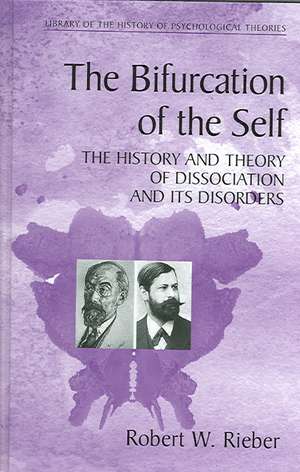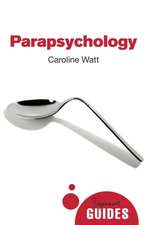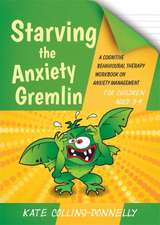The Bifurcation of the Self: The History and Theory of Dissociation and Its Disorders: Library of the History of Psychological Theories
Autor Robert W. Rieberen Limba Engleză Hardback – 27 mar 2006
At the core of this history is a trio of related evolutions—hypnosis, concepts of identity, and dissociation—beginning with nineteenth-century "hysterics" and culminating in the modern boom in Dissociative Identity Disorder (DID) diagnoses and the parallel rise in childhood abuse/repressed memory cases. Rieber does not argue the non-existence of DID; rather he asserts that it is a rare disorder exaggerated by dissociation advocates and exploited by the media. In doing so, he takes on some of the most difficult questions in the field:
- How crucial is memory to a person’s identity?
- Can two or more autonomous personalities actually exist in the same body?
- If trauma causes dissociation, why aren’t there more DID cases?
- Why are DID cases prevalent in some eras but not in others?
- Does dissociative disorder belong in the DSM?
The book is rigorously illustrated with two centuries’ worth of famous cases including Christine Beauchamp, Ansel Bourne, Eve Black/Eve White, and most notably the woman known as "Sybil", whose story is covered in depth with newly revealed manuscripts. And Rieber reviews the current state of DID-related controversy, from the professionals who feel that the condition is underreported to those who consider it a form of malingering, so that readers may draw their own conclusions.
| Toate formatele și edițiile | Preț | Express |
|---|---|---|
| Paperback (1) | 721.77 lei 6-8 săpt. | |
| Springer Us – 23 noi 2010 | 721.77 lei 6-8 săpt. | |
| Hardback (1) | 721.96 lei 6-8 săpt. | |
| Springer Us – 27 mar 2006 | 721.96 lei 6-8 săpt. |
Preț: 721.96 lei
Preț vechi: 759.96 lei
-5% Nou
Puncte Express: 1083
Preț estimativ în valută:
138.14€ • 144.64$ • 114.58£
138.14€ • 144.64$ • 114.58£
Carte tipărită la comandă
Livrare economică 10-24 aprilie
Preluare comenzi: 021 569.72.76
Specificații
ISBN-13: 9780387274133
ISBN-10: 0387274138
Pagini: 304
Ilustrații: XX, 304 p. 7 illus.
Dimensiuni: 155 x 235 x 20 mm
Greutate: 0.57 kg
Ediția:2006
Editura: Springer Us
Colecția Springer
Seria Library of the History of Psychological Theories
Locul publicării:New York, NY, United States
ISBN-10: 0387274138
Pagini: 304
Ilustrații: XX, 304 p. 7 illus.
Dimensiuni: 155 x 235 x 20 mm
Greutate: 0.57 kg
Ediția:2006
Editura: Springer Us
Colecția Springer
Seria Library of the History of Psychological Theories
Locul publicării:New York, NY, United States
Public țintă
Professional/practitionerCuprins
A Brief History of Multiplicity.- The Roots of Multiple Personality Disorder/Dissociative Identity Disorder.- “Nothing but God and the Brain”.- Prying Open the Lid.- Looking Inside the Box, Thinking Outside the Box.- Sybil A Case of Multiple Personalities and the Natural History of a Myth.- The Case of Sybil.- The Publication of a “Psychiatric Masterpiece”.- The Myth Explodes.- Seminal Cases of Multiplicity A History.- Fourteen Seminal Cases.- Bifurcation of Self.
Recenzii
From the reviews:
"Reiber attempts to locate the history of the idea of dissociative states in a social context that owes much to popular hypnotism, Freudian and pseudo-Freudian psychodynamics and concepts of identity. … On reflection, a reader is likely to feel better informed and most likely stimulated by some of the questions Reiber poses. … It asks good questions and keeps the reader asking them long after the book is laid aside." (Mark Welch, Metapsychology–online, September, 2006)
"Book seemingly addresses to psychologists and psychiatrists is Robert W. Rieber’s The Bifurcation of the Self: The History and Theory of Dissociation and its Disorders. … This book will be useful to mental health professionals looking for an overview of selected past ideas and cases of dissociation, particularly DID." (Carlos S. Alcarado, Journal of Scientific Exploration, Vol. 21 (1), 2007)
"Reiber attempts to locate the history of the idea of dissociative states in a social context that owes much to popular hypnotism, Freudian and pseudo-Freudian psychodynamics and concepts of identity. … On reflection, a reader is likely to feel better informed and most likely stimulated by some of the questions Reiber poses. … It asks good questions and keeps the reader asking them long after the book is laid aside." (Mark Welch, Metapsychology–online, September, 2006)
"Book seemingly addresses to psychologists and psychiatrists is Robert W. Rieber’s The Bifurcation of the Self: The History and Theory of Dissociation and its Disorders. … This book will be useful to mental health professionals looking for an overview of selected past ideas and cases of dissociation, particularly DID." (Carlos S. Alcarado, Journal of Scientific Exploration, Vol. 21 (1), 2007)
Textul de pe ultima copertă
For more than a hundred years, dissociative states, sometimes referred to as multiple personality disorder, have fascinated the public as well as scientists. The precise nature of this disorder is a controversial one, dividing clinicians, theorists, and researchers. Challenging the conventional wisdom on all sides, Robert Rieber’s Bifurcation of the Self traces the clinical and social history of dissociation in a provocative examination of this widely debated phenomenon.
At the core of this history is a trio of related evolutions—hypnosis, concepts of identity, and dissociation—beginning with nineteenth-century "hysterics" and culminating in the modern boom in Dissociative Identity Disorder (DID) diagnoses and the parallel rise in childhood abuse/repressed memory cases. Rieber does not argue the non-existence of DID; rather he asserts that it is a rare disorder exaggerated by dissociation advocates and exploited by the media. In doing so, he takes on some of the most difficult questions in the field:
At the core of this history is a trio of related evolutions—hypnosis, concepts of identity, and dissociation—beginning with nineteenth-century "hysterics" and culminating in the modern boom in Dissociative Identity Disorder (DID) diagnoses and the parallel rise in childhood abuse/repressed memory cases. Rieber does not argue the non-existence of DID; rather he asserts that it is a rare disorder exaggerated by dissociation advocates and exploited by the media. In doing so, he takes on some of the most difficult questions in the field:
- How crucial is memory to a person’s identity?
- Can two or more autonomous personalities actually exist in the same body?
- If trauma causes dissociation, why aren’t there more DID cases?
- Why are DID cases prevalent in some eras but not in others?
- Does dissociative disorder belong in the DSM?
Caracteristici
Uses case history methodology to illustrate the relationship between theory and practice of the study of Dissociation Identity Disorder (DID) Reviews the current state of DID-related controversy so that readers may draw their own conclusions Examines the evolution of hypnosis and the ways it has been used and misused in the treatment of cases with DID Discusses the cultural fascination with Multiple Personality Disorder (MPD) and the underlying implications for social identity Includes supplementary material: sn.pub/extras
















